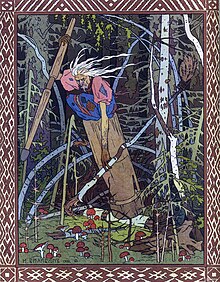Russian fairy tales are fascinating, so would love to make a Russian fairy tale recipe. Perhaps with Vasilisa the beautiful as inspiration, which also reminds me of a Russian friend i once had, Elena.
The fairy tale goes some thing like this:
A merchant had, by his first wife, a single daughter, who was known as Vasilisa the Beautiful. When she was eight years old, her mother died. On her deathbed, she gave Vasilisa a tiny wooden doll with instructions to give it a little to eat and a little to drink if she were in need, and then it would help her. As soon as her mother died, Vasilisa gave it a little to drink and a little to eat, and it comforted her.
After a time, her father remarried to a woman with two daughters. Her stepmother was very cruel to her, but with the help of the doll, Vasilisa was able to perform all the tasks imposed on her. When young men came wooing, the stepmother rejected them all because it was not proper for the younger to marry before the older, and none of the suitors wished to marry Vasilisa's stepsisters.
One day the merchant had to embark on a journey. His wife sold the house and moved them all to a gloomy hut by the forest. One day she gave each of the girls a task and put out all the fires except a single candle. Her older daughter then put out the candle, whereupon they sent Vasilisa to fetch light from Baba Yaga's hut. The doll advised her to go, and she went. While she was walking, a mysterious man rode by her in the hours before dawn, dressed in white, riding a white horse whose equipment was all white; then a similar rider in red. She came to a house that stood on chicken legs and was walled by a fence made of human bones. A black rider, like the white and red riders, rode past her, and night fell, whereupon the eye sockets of the skulls became luminous. Vasilisa was too frightened to run away, and so Baba Yaga found her when she arrived in her mortar.
Baba Yaga said that she must perform tasks to earn the fire, or be killed. For the first task, Vasilisa was to clean the house and yard, cook supper, and pick out black grains and wild peas from a quarter measure of wheat. Baba Yaga left, and Vasilisa cooked, while the doll did everything else. At dawn, the white rider passed; at or before noon, the red. As the black rider rode past, Baba Yaga returned and could complain of nothing. She bade three pairs of disembodied hands seize the grain to grind it, and set Vasilisa the same tasks for the next day, with the addition of cleaning poppy seeds that had been mixed with dirt. Again, the doll did everything but cook the meal. Baba Yaga set the three pairs of hands to press the oil from the poppy seeds.
Vasilisa asked about the riders' identities and was told that the white one was Day, the red one the Sun, and the black one Night. Other details are not explained, on the grounds that Baba Yaga preferred to keep them secret. In return, Baba Yaga inquired into the cause of Vasilisa's success. On hearing the answer "by my mother's blessing", Baba Yaga sends Vasilisa home with a skull-lantern to provide light for her step-family, only to find that, since sending her out on her task, no candles or fire will light in their home. Even lamps and candles brought in from outside snuff out the second they are carried over the threshold. The light burns Vasilisa's stepmother and stepsisters to ashes, and Vasilisa buries the skull as per its instructions so no person would ever be harmed by it.
Later, Vasilisa becomes an assistant to a maker of cloth in Russia's capital city, where she becomes so skilled at her work that the czar himself notices her skill; he later marries Vasilisa.
Now that we know the fairy tale, the question is what recipe goes well with this fairy tale? Perhaps a nice Russian recipe. Maybe our Russian friends could help us with suggestions?
Now that we know the fairy tale, the question is what recipe goes well with this fairy tale? Perhaps a nice Russian recipe. Maybe our Russian friends could help us with suggestions?


No comments:
Post a Comment